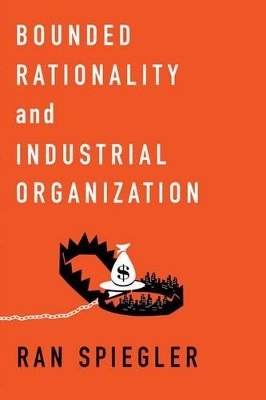
Bounded Rationality and Industrial Organization
Oxford University Press Inc (Verlag)
978-0-19-933426-1 (ISBN)
Grounded in key observations in consumer psychology, Bounded Rationality and Industrial Organization develops non-standard models of "boundedly rational" consumer behavior and embeds them into familiar models of markets. It then rigorously analyses each model in the tradition of microeconomic theory, leading to a richer, more realistic picture of consumer behavior. Ran Spiegler analyses phenomena such as exploitative price plans in the credit market, complexity of financial products and other obfuscation practices, consumer antagonism to unexpected price increases, and the role of default options in consumer decision making. Spiegler unifies the relevant literature into three main strands: limited ability to anticipate and control future choices, limited ability to understand complex market environments, and sensitivity to reference points.
Although the challenge of enriching the psychology of decision makers in economic models has been at the frontier of theoretical research in the last decade, there has been no graduate-level, theory-oriented textbook to cover developments in the last 10-15 years. Thus, Bounded Rationality and Industrial Organization offers a welcome and crucial new understanding of market behavior-it challenges conventional wisdom in ways that are interesting and economically significant, and which in the end effect the well-being of all market participants.
Professor of Economics at Tel Aviv University and University College London
1 Introduction ; 1.1 Bibliographic Notes ; I Anticipating Future Preferences ; 2 Dynamically Inconsistent Preferences I: Unconstrained Contracting ; 2.1 The Multi-Selves Model ; 2.1.1 Naivety ; 2.2 Monopoly Pricing ; 2.2.1 Optimal Price Schemes for Sophisticated Consumers ; 2.2.2 Optimal Price Schemes for Naive Consumers ; 2.2.3 Screening the Consumer's Type ; 2.3 Competitive Pricing ; 2.4 Welfare Analysis ; 2.5 Educating Naive Consumers ; 2.6 The Interpretation of Naivety ; 2.7 Two Applications ; 2.8 Other Topics ; 2.8.1 The (?, ?) Model ; 2.8.2 Preference Heterogeneity ; 2.9 Summary ; 2.10 Bibliographic Notes ; 3 Dynamically Inconsistent Preferences II: Constrained Contracting ; 3.1 Two-Part Tariffs ; 3.1.1 Departure from Marginal-Cost Pricing ; 3.1.2 Welfare Analysis ; 3.2 Destabilization of Commitment Devices: Renegotiation and Spot Market ; Competition ; 3.3 Self-Control ; 3.3.1 Implications for Monopoly Pricing ; 3.3.2 Do Self-Control Costs Hamper Competition? ; 3.4 Summary ; 3.5 Bibliographic Notes ; 4 Dynamically Inconsistent Preferences III: Partial Naivety ; 4.1 Magnitude Naivety ; 4.1.1 Monopoly Pricing ; 4.1.2 Are More Sophisticated Consumers Always Better Off? ; 4.2 Frequency Naivety ; 4.2.1 First-Best Monopoly Pricing ; 4.2.2 Second-Best Monopoly Pricing ; 4.2.3 Does Competition Curb Exploitation? ; 4.3 Summary ; 4.4 Bibliographic Notes ; 5 Biased Beliefs without Dynamic Inconsistency ; 5.1 Monopoly Pricing with Over-Optimistic Consumers ; 5.1.1 Comparison with Related Models ; 5.2 Overconfidence: Three-Part Tariffs ; 5.3 Unforeseen Contingencies: Add-On Pricing ; 5.4 A Summary Exercise: Insurance Markets with Biased Consumers ; 5.4.1 Equilibrium Analysis when Subjective Beliefs are Observable ; 5.4.2 Equilibrium Analysis when Subjective Beliefs are Private Information ; 5.5 Summary ; 5.6 Bibliographic notes ; A Appendix to Part I: A Decision-Theoretic Perspective ; A.1 The Multi-Selves Model ; A.2 Self-Control Preferences ; A.3 The Relation between Self-Control Preferences and the Multi-Selves Model ; A.4 Other Classes of Temptation-Driven Preferences ; A.5 Bibliographic Notes ; II Responding to Market Complexity ; 6 Sampling-Based Reasoning: Price Competition and Product Differentiation ; 6.1 A Sampling-Based Choice Procedure ; 6.2 Price Competition and Technology Adoption ; 6.2.1 Nash Equilibrium ; 6.2.2 Welfare Analysis ; 6.3 Spurious Product Differentiation ; 6.3.1 Nash Equilibrium ; 6.3.2 Product Complexity as a Differentiation Device ; 6.4 Can the Market Educate Consumers? ; 6.5 Summary ; 6.6 Bibliographic Notes ; 7 Sampling-Based Reasoning: Obfuscation ; 7.1 A Model of Competitive Obfuscation ; 7.1.1 Nash Equilibrium ; 7.1.2 Welfare Analysis ; 7.2 Production Inefficiencies ; 7.3 Multi-Dimensional Prices ; 7.4 A Market Intervention: Introducing /Simple" Options ; 7.5 Summary ; 7.6 Bibliographic Notes ; 8 Coarse Reasoning ; 8.1 A Modeling Framework ; 8.2 Complex Price Patterns as a Discrimination Device ; 8.2.1 "DeBruijn" Price Sequences ; 8.2.2 Conditions for Profitability of Complex Price Patterns ; 8.3 Limited Understanding of Adverse Selection ; 8.3.1 A Buyer-Seller Example ; 8.3.2 A Benchmark: A Bayesian-Rational Buyer ; 8.3.3 A /Coarse" Buyer ; 8.3.4 Action-Dependent Feedback ; 8.4 Summary ; 8.5 Bibliographic Notes ; III Reference Dependence ; 9 Loss Aversion ; 9.1 Expected Price as a Reference Point: Monopoly Pricing ; 9.1.1 Reduced Price Variability ; 9.1.2 Impact on Expected Prices ; 9.2 Price Uniformity in a Duopoly Setting: /Kinked" Demand ; 9.3 Expected Consumption as a Reference Point: An /Attachment Effect" ; 9.3.1 Personal Equilibrium ; 9.3.2 Price Randomization ; 9.4 Discussion ; 9.4.1 Actual Prices as Reference Points ; 9.4.2 Pleasant Surprises ; 9.5 Summary ; 9.6 Bibliographic Notes ; 10 Inertia I: Price Competition ; 10.1 Price Competition under Consumer Inertia ; 10.2 Price-Frame Competition ; 10.2.1 Nash Equilibrium ; 10.2.2 Equilibrium Properties ; 10.2.3 Two Market Interventions ; 10.3 Consumer Switching ; 10.4 Asymmetric Default Assignment ; 10.5 A Few General Remarks ; 10.5.1 More than Two Frames ; 10.5.2 Revealed Preferences ; 10.6 Summary ; 10.7 Bibliographic Notes ; 11 Inertia II: Costly Marketing 261 ; 11.1 A Model of Competitive Marketing ; 11.2 Nash Equilibrium ; 11.3 The Effective Marketing Property ; 11.4 Discussion ; 11.5 Summary ; 11.6 Bibliographic Notes ; IV Discussion ; 12 Recurring Themes ; 12.1 Complex Pricing Strategies ; 12.2 Spurious Variety ; 12.3 Market Transactions as a Form of Speculative Trade ; 12.4 How Effective are Competition and Consumer Protection Policies? ; 12.5 Externalities between Rational and Boundedly Rational Consumers ; 12.6 Conclusion ; 13 But Can't we Get the Same Thing with a Standard Model? ; 13.1 Rationalization via Modified Information ; 13.2 Rationalization via Modified Preferences ; 13.3 Rationalization via Endogenization ; 13.4 Discussion ; 13.5 Epilogue ; 13.6 Bibliographic Notes ; Bibliography ; Index
| Verlagsort | New York |
|---|---|
| Sprache | englisch |
| Maße | 231 x 155 mm |
| Gewicht | 340 g |
| Themenwelt | Geisteswissenschaften ► Psychologie ► Verhaltenstherapie |
| Wirtschaft ► Allgemeines / Lexika | |
| Wirtschaft ► Betriebswirtschaft / Management ► Marketing / Vertrieb | |
| Wirtschaft ► Volkswirtschaftslehre ► Mikroökonomie | |
| ISBN-10 | 0-19-933426-9 / 0199334269 |
| ISBN-13 | 978-0-19-933426-1 / 9780199334261 |
| Zustand | Neuware |
| Informationen gemäß Produktsicherheitsverordnung (GPSR) | |
| Haben Sie eine Frage zum Produkt? |
aus dem Bereich


